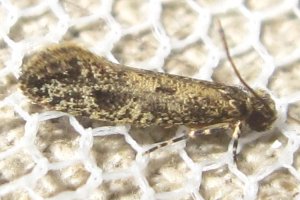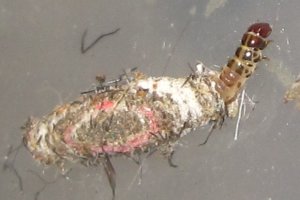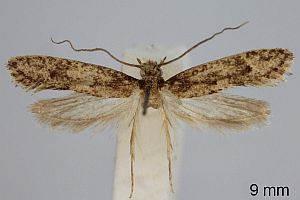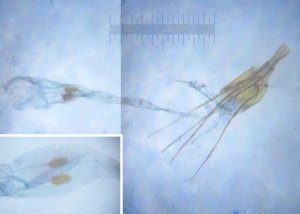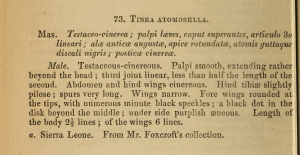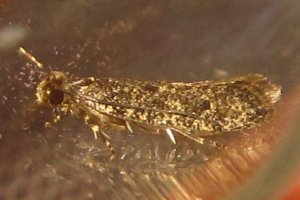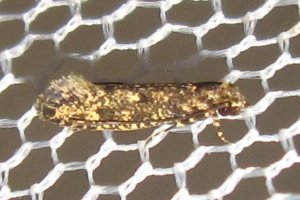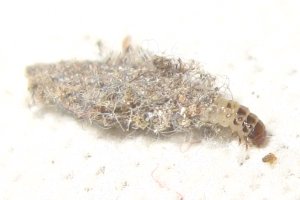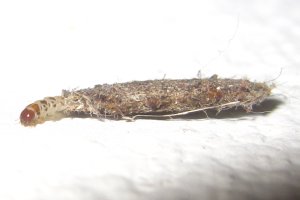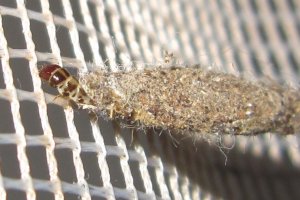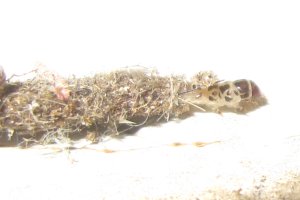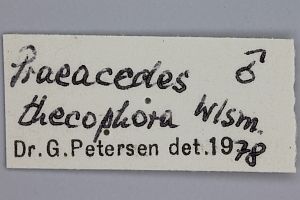

 +8Kontinente:EUAFSA
+8Kontinente:EUAFSA1. Lebendfotos
1.1. Falter
1.2. Raupe
1.3. Puppenexuvie
2. Diagnose
2.1. Männchen
2.2. Genitalien
2.2.1. Männchen
2.2.2. Weibchen
2.3. Erstbeschreibung
3. Biologie
3.1. Nahrung der Raupe
Wie bei den meisten detritophagen Tineiden-Raupen weiß man über die genaue Raupennahrung nur wenig bescheid. Bippus (2016: 159-160) schreibt zu seinen Funden in La Possession (La Réunion): "I find their larval cases regularly at my home and its terrace throughout the year. [...] Both species feed on insect detritus. Although there are mentions on species of their genus that might feed on pigeon dung (Zimmermann, 1978), clothes, bird feathers or spider webs (Arakelian, 2010) I had the impression that many of former notifications of food sources might be erroneously reported. [...] I also find regularly their cases suspended near spider webs though I believe that they were attracted by the insects caught in the spider webs or their remains. It might be notable that I often find other arthropods as Acari Leach, 1817 on the insect detritus and I cannot exclude that the moths larvae might also feed on them."
4. Weitere Informationen
4.1. Andere Kombinationen
- Tinea atomosella Walker, 1863 [Originalkombination]
4.2. Synonyme
- Tinea seminolella Beutenmuller, 1889
- Tinea thecophora Walsingham, 1908
- Tinea despecta Meyrick, 1919
- Praeacedes deluccae Amsel, 1954
- Antitinea deluccae Amsel, 1955
- Tinea malgassica Gozmány, 1970
- Tinea decui Căpuşe & Georgescu, 1977
4.3. Faunistik
Die Art wurde aus Sierra Leone beschrieben, gilt nach Lopez-Vaamonde et al. (2010: 655) aber als "cryptogenic", d.h. ihre ursprüngliche Heimat ist nicht mehr rekonstruierbar. Nach Gaedike (2019: 52) wurde die Art in Europa zuerst 1953 auf Madeira gefunden, später dann auf Zypern, Malta, den Kanaren und Azoren. Bis auf die Kanaren findet sich diese Liste auch schon bei Lopez-Vaamonde et al. (2010: 655), wobei auch jene Autoren von Einschleppung auf diese Inseln ausgehen.
Sammut (1984: 82) hatte zu Malta vermerkt: "One example collected by M.Zammit from Poala." Wir behandeln den Fund als Einzelnachweis, aber es ist wohl auch hier eher von Etablierung auszugehen.
(Autor: Erwin Rennwald)
4.4. Literatur
- Bippus, M. (2016): Praeacedes atomosella (Walker, 1863) and Phereoeca praecox Gozmány & Vári, 1973 – two case-bearing moths new to the Fauna of La Réunion (Lepidoptera: Tineidae). — Contributions to Entomology 66 (2): 159-163 [PDF auf contributions-to-entomology.org].
- Gaedike, R. (2019): Tineidae II (Myrmecozelinae, Perissomasticinae, Tineinae, Hieroxestinae, Teichobiinae and Stathmopolitinae). — In: Karsholt, O., Mutanen, M. & M. Nuss (2019): Microlepidoptera of Europe 9: I-XXIII, 1-248. Leiden – Boston (Brill).
- Lopez-Vaamonde, C., Agassiz, D., Augustin, S., de Prins, J., de Prins, W., Gomboc, S., Ivinskis, P., Karsholt, O., Koutroumpas, A., Koutroumpa, F., Laštůvka, Z., Marabuto, E., Olivella, E., Przybylowicz, L., Roques, A., Ryrholm, N., Šefrová, H., Šima, P., Sims, I., Sinev, S., Skulev, B., Tomov, R., Zilli, A. & D. Lees (2010): Lepidoptera. Chapter 11. In: Roques, A. et al. [eds.] (2010): Alien terrestrial arthropods of Europe. — BioRisk, 4(2): 603–668. doi: 10.3897/biorisk.4.50. [zur Arbeit auf biorisk.pensoft.net]
- Sammut, P. M. (1984): A Systematic and Synonymic List of the Lepidoptera of the Maltese Islands. — Neue Entomologische Nachrichten 13: 1-124. [PDF auf zobodat.at]
- Erstbeschreibung: Walker, F. (1863): List of the Specimens of Lepidopterous Insects in the Collection of the British Museum 28: 287-561. London.









